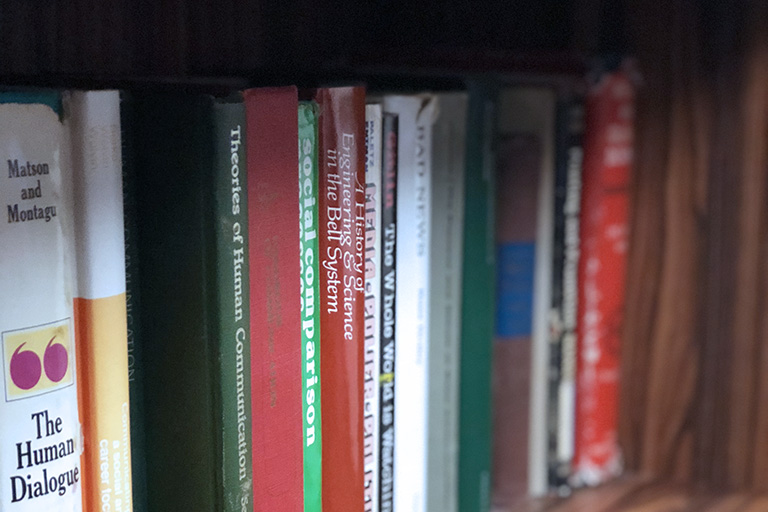Atkin, C.K., Smith, S.W., Roberto, A., Fediuk, T., & Wagner, T. (2002). Correlates of verbally aggressive communication in adolescents. Journal of Applied Communication Research, 30, 251-268. Doi:10.1080/00909880216585
Boster, F.J. (2002). On making progress in communication science. Human Communication Research, 28, 473-490.
Boster, F.J., & Cruz, M.G. (2002). Persuading in the small group context. In J.P. Dillard & M. Pfau (Eds.), (pp. 477-494). Thousand Oaks, CA: The persuasion handbook: Developments in theory and practice Sage.
Bresnahan, M.J., & Levine, T.R. (2002). Appreciating cultural differences. In W. Donohue & L. Massi (Eds.), Communicating and connecting: The functions of human communication (pp. 205-229). Orlando, FL: Harcourt Brace & Company.
Bresnahan, M.J., & Murray-Johnson, L. (2002). The healing web. Health Care for Women International, 10, 1-12.
Bresnahan, M.J., Ohashi, R., Morinaga, S., Yang, L., & Mosher, D. (2002). Cultural Differences in Responding to Criticism: Evidence from the People’s Republic of China, Japan, and the U.S. Asian Journal of Social Psychology, 5, 93-105.
Bresnahan, M.J., Ohashi, R., Shearman, S., Lee, S.Y., Park, C.Y., & Mosher, D. (2002). How Honest is an Honest Opinion? Personal and Cultural Differences in Perceptions of Appropriateness and Liking. Journal of Intercultural Communication, 31, 127-146.
Donohue, W.A., & Hoobler, G.D. (2002) Relational frames and their ethical implications in international negotiation: An analysis based on the Oslo II negotiations. International Negotiation, 7, 143-167.
Donohue, W.D., & Hoobler, G.D. (2002). Relational ripeness in the Oslo I and Oslo II negotiations. In Eytan Gilboa (ed.), Media and conflict: Framing issues, making policy, shaping opinions (pp. 65-88). Ardsley, NY: Transnational Publishers.
Greenberg, B.S., & Smith, S.W. (2002). Daytime talk shows: Up close and in your face. In J. D. Brown, J. R. Steele, & Walsh-Childers, K. (Eds.), Sexual teens, sexual media (pp. 79-93). Hillsdale, NJ: Erlbaum.
Jang, S.A., Smith, S.W., & Levine, T.R. (2002). To stay or to leave? The role of attachment styles in communication patterns and potential termination of romantic relationships following discovery of deception. Communication Monographs, 69, 236-252. Doi:10.1080/03637750216543
Kopfman, J.E., Smith, S.W., Morrison, K., Lindsey, L.L.M., & Yoo, J. (2002). The influence of race on cognitive and affective reactions to organ donation messages. Transplantation Proceedings, 34, 8, 3035-3041.
Levine, T.R., Lapinski, M.K., Banas, J., Wong, N., Hu, A.D.S., Endo, K., Baum, K.L., & Anders, L.N. (2002). Self-construal and self-other benefit as determinants of deceptive message generation. Journal of Intercultural Communication Research, 31, 29-48.
Mastro, D., Eastin, M., & Tamborini, R. (2002). Internet search behavior and mood alteration: A selective exposure approach. Media Psychology, 4, 157-172.
Miller, V.D., Callies, L.N., & Fritz, J.H. (2002). Socialization. In W. A. Donohue & L. L. Massi (Eds.), Communicating and connecting: Functions of human communication (2nd ed.) (pp. 101-119). Ft. Worth, TX: Harcourt Brace College.
Park, H.S., Levine, T.R., McCornack, S.A., Morrison, K., & Ferrara, M. (2002). How people really detect lies. Communication Monographs, 69, 144-157.
Sherry, J.L. (2002). Media saturation and entertainment-education. Communication Theory, 12, 206-224.
Smith, S.W., & Wilson, S.R. (2002). Using social knowledge in communication: Interpreting and forming messages. In Donohue, W. A., & Massi, L. L. (Eds.), Communicating and connecting: Functions of human communication (2nd ed., pp.41-58). Dubuque, IA: Kendall/Hunt.
